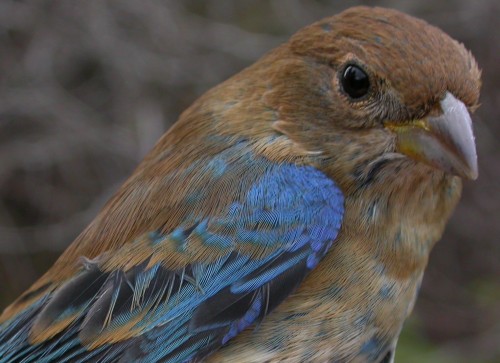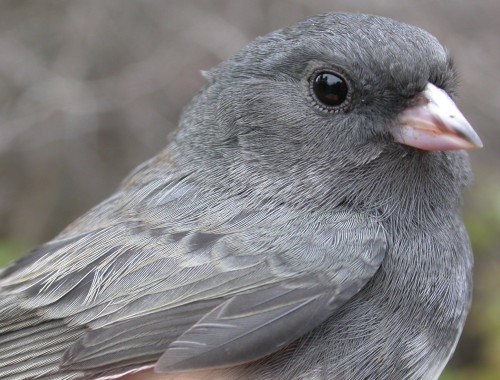|
McGILL BIRD OBSERVATORY |
||||||||||||||||||||||||||||||||||||||||||||||||||||||||||||||||||||||
Welcome
to the McGill Bird Observatory weekly report.
Click here for a complete listing of our archives.
Banders-in-charge:
Marie-Anne Hudson, Barbara Frei,
Marcel Gahbauer Notes: It is with a bittersweet feeling that we end our 2006 Fall Migration Monitoring Program at McGill Bird Observatory. It has been another very good season, with plenty of noteworthy moments and memories along the way. So, as much as we'll all enjoy being able to sleep in until (considerably) after dawn, we'll miss the many birds and people we've become used to seeing on such a regular basis. We hope that in spring we can welcome back not only some of the many birds we've observed over the past three months, but also many of the great volunteers who played such an important role in making this season another resounding success. Unfortunately the weather over the final week was rather unpleasant, with plenty of wind, rain, and cold temperatures resulting in two days of closed nets and two more with highly reduced net hours. This led to a rather low weekly banded total of only 94 birds. While the weather was less than ideal most days, the worst was saved for the weekend. After a second half of October that was already wetter than usual, Saturday brought another 43 mm of rain, putting net H1 back under the floodline, and creating deep pools along many of the trails. Then on Sunday Mother Nature was particularly thorough, dispensing a mix of rain, drizzle, freezing rain, ice pellets, and wet snow throughout the morning, often several types within a few minutes of each other! All this was accompanied by a brisk wind that began around 45 km/h and escalated to 60 by noon, with gusts to over 90. Obviously banding was out of the question, but surprisingly there were a lot of birds to be observed, including plenty of late-migrating kinglets staying close to the ground in relatively sheltered areas, and several Turkey Vultures careening across the sky most uncharacteristically. Despite the weather and the lateness of the season, there were some very interesting sightings this week. During a gloomy Tuesday morning census, a Philadelphia Vireo was seen well as it flitted among the treetops along the back path by Stoneycroft Pond. This surprise was eclipsed on Friday by a remarkably late Indigo Bunting that flew into net B2 and gave everyone an unexpectedly colourful highlight for the day. Also of note, solitary Eastern Bluebirds were seen on Friday and Sunday, and on the final morning, three bluebirds sang a sweet and melancholy farewell at dawn before flying away toward the rising sun. While the fall migration season has come to an end, we now need to catch up on data management - both computer entry of all the banding data, and analysis for the annual fall report. We hope to have the report available on the website within the next 4-6 weeks; it will be posted in the banding log section once it is ready.
The much lower banding numbers and reduced diversity during the final week of fall are reflected clearly in the table above, where even species banded a single time during the week made the top ten. American Robins remained by far the most numerous bird in the nets, continuing the dominance they've shown throughout the past three weeks. The increase in American Tree Sparrows and Slate-coloured Juncos reflects the approach of winter, though both are much scarcer than at this time last year, and the virtual absence of Fox Sparrows is remarkable given that they were among the most abundant week 13 species in 2005. The five most abundant species in the area were the same as last week, though their rankings were rearranged a bit this week. Robins especially have started to taper off noticeably, although the numbers remain impressive. On the other hand, the Black-capped Chickadees that have been fairly quiet for most of the fall started becoming much more active and vocal this week, bringing them back into the top ten. Most of the individuals we've had a chance to look at are banded, so we expect that the majority of them are the local birds banded last winter or previously, plus their offspring from this year. The old regulars have probably been waiting for the feeders to go back up, and in fact when the first ones were put out on Sunday, two chickadee advance scouts were there within less than 15 minutes! Although the fall season has come to an end, MBO will remain active throughout the winter as it has in the past. Feeders will be stocked from now through the end of March, and we hope to again attract a wide variety of sparrows, finches, woodpeckers, and others. Banding will take place on a much reduced frequency, once or twice a week (weather permitting), and will be of much more limited scope than during migration. Weekly reports will continue to be posted on the website throughout winter.
|



